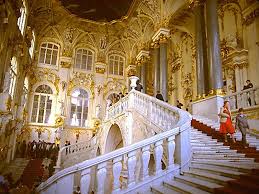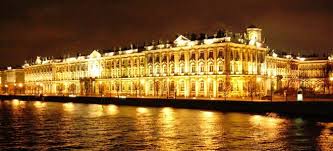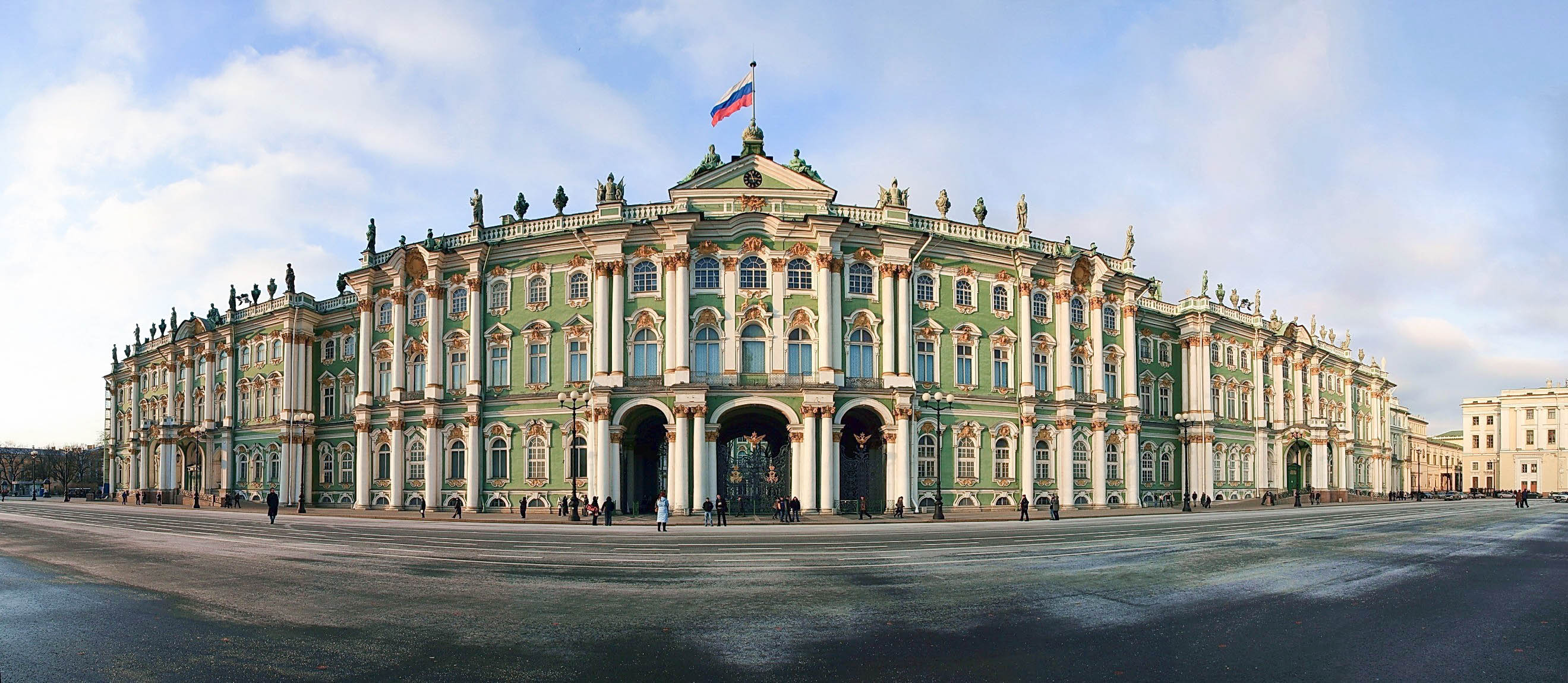The State Hermitage is a museum of art and culture in Saint Petersburg, Russia. One of the largest[ and oldest museums in the world, it was founded in 1764 by Catherine the Great and has been open to the public since 1852. Its collections, of which only a small part is on permanent display, comprise over three million items, including the largest collection of paintings in the world. The collections occupy a large complex of six historic buildings along Palace Embankment, including the Winter Palace, a former residence of Russian emperors. Apart from them, the Menshikov Palace, Museum of Porcelain, Storage Facility at Staraya Derevnya and the eastern wing of the General Staff Building are also part of the museum. The museum has several exhibition centers abroad. The Hermitage is a federal state property. Since 1990, the director of the museum has been Mikhail Piotrovsky.
Of six buildings of the main museum complex, five, named the Winter Palace, Small Hermitage, Old Hermitage, New Hermitage and Hermitage Theatre, are open to the public. The entrance ticket for foreign tourists costs more than the fee paid by citizens of Russia and Belarus. However, entrance is free of charge the first Thursday of every month for all visitors, and free daily for students and children. The museum is closed on Mondays. The entrance for individual visitors is located in the Winter Palace, accessible from the Courtyard.
Originally, the only building housing the collection was the 'Small Hermitage'. Today, the Hermitage Museum encompasses many buildings on the Palace Embankment and its neighbourhoods. Apart from the Small Hermitage, the museum now also includes the 'Old Hermitage' (also called 'Large Hermitage'), the 'New Hermitage', the 'Hermitage Theatre', and the 'Winter Palace', the former main residence of the Russian tsars. In recent years, the Hermitage has expanded to the General Staff Building on the Palace Square in front of the Winter Palace, and the Menshikov Palace.
Catherine the Great started her art collection in 1764 by purchasing paintings from Berlin merchant Johann Ernst Gotzkowsky. He assembled the collection for Frederick II of Prussia who ultimately refused to purchase it. Thus, Gotzkowsky provided 225 or 317 paintings (conflicting accounts list both numbers), mainly Flemish and Dutch, including 90 not precisely identified, to the Russian crown. The collection consisted of Rembrandt (13 paintings), Rubens (11 paintings), Jacob Jordaens (7 paintings), Anthony van Dyck (5 paintings), Paolo Veronese (5 paintings), Frans Hals (3 paintings, including Portrait of a Young Man with a Glove), Raphael (2 paintings), Holbein (2 paintings), Titian (1 painting), Jan Steen (The Idlers), Hendrik Goltzius, Dirck van Baburen, Hendrick van Balen and Gerrit van Honthorst. Perhaps some of the most famous and most notable artwork that was a part of Catherine’s original purchase from Gotzkowsky was: Danae, painted by Rembrandt in 1636, Descent from the Cross, painted by Rembrandt in 1624, and Portrait of a Young Man Holding a Glove painted by Frans Hals in 1650. These paintings remain in the Hermitage collection today and were purchased by Catherine in 1764 among many others that were a part of Johann Ernst Gotzkowsky’s collection.
In 1764, Catherine commissioned Yury Felten to build an extension on the east of the Winter Palace which he completed in 1766. Later it became the Southern Pavilion of the Small Hermitage. In 1767–1769, French architect Jean-Baptiste Vallin de la Mothe built the Northern Pavilion on the Neva embankment. Between 1767 and 1775, the extensions were connected by galleries, where Catherine put her collections.The entire neoclassical building is now known as the Small Hermitage. During the time of Catherine, the Hermitage was not a public museum and few people were allowed to view its holdings. Jean-Baptiste Vallin de la Mothe also rebuilt rooms in the second story of the south-east corner block that was originally built for Elizabeth and later occupied by Peter III. The largest room in this particular apartment was the Audience Chamber (also called the Throne Hall) which consisted of 227 square meters.
The Hermitage buildings served as a home and workplace for nearly a thousand people, including the Imperial family. In addition to this, they also served as an extravagant showplace for all kinds of Russian relics and displays of wealth prior to the art collections. Many events were held in these buildings including masquerades for the nobility, grand receptions and ceremonies for state and government officials. The “Hermitage complex” was a creation of Catherine’s that allowed all kinds of festivities to take place in the palace, the theatre and even the museum of the Hermitage. This helped solidify the Hermitage as not only a dwelling place for the Imperial family, but also as an important symbol and memorial to the imperial Russian state. Today, the palace and the museum are one and the same. In Catherine’s day, the Winter Palace served as a central part of what was called the Palace Square. The Palace Square served as St. Petersburg’s nerve center by linking it to all the city’s most important buildings. The presence of the Palace Square was extremely significant to the urban development of St. Petersburg, and while it became less of a nerve center later into the 20th century, its symbolic value was still very much preserved.
Catherine acquired the best collections offered for sale by the heirs of prominent collectors. In 1769, she purchased Brühl's collection, consisting of over 600 paintings and a vast number of prints and drawings, in Saxony. Three years later, she bought Crozat's collection of paintings in France with the assistance of Denis Diderot. Next, in 1779, she acquired the collection of 198 paintings that once belonged to Robert Walpole in London followed by a collection of 119 paintings in Paris from Count Baudouin in 1781. Catherine’s favorite items to collect were believed to be engraved gems and cameos. At the inaugural exhibit of the Hermitage, opened by the Prince of Wales in November 2000, there was an entire gallery devoted to representing and displaying Catherine’s favorite items. In this gallery her cameos are displayed along with cabinet made by David Roentgen, which holds her engraved gems. As the symbol of Minerva was frequently used and favored by Catherine to represent her patronage of the arts, a cameo of Catherine as Minerva is also displayed here. This particular cameo was created for her by her daughter-in-law, the Grand Duchess Maria Fyodorovna. This is only a small representation of Catherine’s vast collection of many antique and contemporary engraved gems and cameos.
The collection soon overgrew the building. In her lifetime, Catherine acquired 4,000 paintings from the old masters, 38,000 books, 10,000 engraved gems, 10,000 drawings, 16,000 coins and medals and a natural history collection filling two galleries, so in 1771 she commissioned Yury Felten to build another major extension. The neoclassical building was completed in 1787 and has come to be known as the Large Hermitage or Old Hermitage. Catherine also gave the name of the Hermitage to her private theatre, built nearby between 1783 and 1787 by the Italian architect Giacomo Quarenghi. In London in 1787, Catherine acquired the collection of sculpture that belonged to Lyde Browne, mostly Ancient Roman marbles. Catherine used them to adorn the Catherine Palace and park in Tsarskoye Selo, but later they became the core of the Classical Antiquities collection of the Hermitage. From 1787 to 1792, Quarenghi designed and built a wing along the Winter Canal with the Raphael Loggias to replicate the loggia in the Apostolic Palace in Rome designed by Donato Bramante and frescoed by Raphael. The loggias in Saint Petersburg were adorned with copies of Vatican frescoes painted by Cristopher Unterberger and his workshop in the 1780s.
Catherine succeeded in accomplishing a huge achievement in the art world. She collected thousands of impressive pieces of artwork that were numerous in size and value. In her collection, at least 4,000 paintings came to rival the older and more prestigious museums of Western Europe. Catherine took great pride in her collection, and actively participated in extensive competitive art gathering and collecting that was prevalent in European royal court culture. Through Catherine’s art collection, she gained European acknowledgment and acceptance, and portrayed Russia as an enlightened society, another feat that Catherine took great pride in. Catherine went on to invest much of her identity in being a patron for the arts. She was particularly fond of the popular deity, Minerva, whose characteristics according to classical tradition are symbolic of military prowess, wisdom, and patronage of the arts. Using the title, Catherine the Minerva, she personally created new institutions of literature and culture and also participated in many projects of her own, mostly having to do with play writing. The representation of Catherine alongside Minerva would come to be a known tradition of enlightened patronage in Russia.
In 1815, Alexander I of Russia purchased 38 pictures from the heirs of Joséphine de Beauharnais, most of which had been looted by the French in Kassel during the war. The Hermitage collection of Rembrandts was then considered the largest in the world. Also among Alexander's purchases from Josephine's estate were the first four sculptures by the neoclassical Italian sculptor Antonio Canova to enter the Hermitage collection.
Eventually the imperial collections were enriched by Greek and Scythian artifacts excavated within the Russian Empire.
Between 1840 and 1843, Vasily Stasov redesigned the interiors of the Southern Pavilion of the Small Hermitage. In 1838, Nicholas I commissioned the neoclassical German architect Leo von Klenze to design a building for the public museum. Space for the museum was made next to the Small Hermitage by the demolition of the Shepelev Palace and royal stables. The construction was overseen by the Russian architects Vasily Stasov and Nikolai Yefimov in 1842–1851 and incorporated Quarenghi's wing with the Raphael Loggias.
In 1851, in Venice the museum acquired the collection of Cristoforo Barbarigo, including five more canvases by Titian. Today, all of the paintings but one (Danaë) by Titian in the Hermitage Museum came to St. Petersburg from the Barbarigo collection.
The New Hermitage was opened to the public on 5 February 1852. In the same year the Egyptian Collection of the Hermitage Museum emerged, and was particularly enriched by items given by the Duke of Leuchtenberg, Nicholas I's son-in-law. Meanwhile in 1851–1860, the interiors of the Old Hermitage were redesigned by Andrei Stackensneider to accommodate the State Assembly, Cabinet of Ministers and state apartments. Andrei Stakenschneider created the Pavilion Hall in the Northern Pavilion of the Small Hermitage in 1851–1858.
Until the 1920s, the museum's entrance was under the portico supported by five-metre high atlantes of grey Serdobol granite from Finland in the middle of the southern facade of the New Hermitage building.
In 1861, the Hermitage purchased from the Papal government part of the Giampietro Campana collection, which consisted mostly classical antiquities. These included over 500 vases, 200 bronzes and a number of marble statues. The Hermitage acquired Madonna Litta, which was then attributed to Leonardo, in 1865, and Raphael's Connestabile Madonna in 1870. In 1884 in Paris, Alexander III of Russia acquired the collection of Alexander Basilewski, featuring European medieval and Renaissance artifacts. In 1885, the Arsenal collection of arms and armour, founded by Alexander I of Russia, was transferred from the Catherine Palace in Tsarskoye Selo to the Hermitage. In 1914, Leonardo's Benois Madonna was added to the collection.
Immediately after the Revolution of 1917 the Imperial Hermitage and Winter Palace, former Imperial residence, were proclaimed state museums and eventually merged.
The range of the Hermitage's exhibits was further expanded when private art collections from several palaces of the Russian Tsars and numerous private mansions were nationalized and redistributed among major Soviet state museums. Particularly notable was the influx of old masters from the Catherine Palace, the Alexander Palace, the Stroganov Palace and the Yusupov Palace as well as from other palaces of Saint Petersburg and suburbs.
In 1922, an important collection of 19th-century European paintings was transferred to the Hermitage from the Academy of Arts. In turn, in 1927 about 500 important paintings were transferred to the Central Museum of old Western art in Moscow at the insistence of the Soviet authorities. In the early 1930s, 70 more paintings were sent there. After 1932, a number of less significant works of art were transferred to new museums all over the Soviet Union.
In 1928, the Soviet government ordered the Hermitage to compile a list of valuable works of art for export. In 1930–1934, over two thousand works of art from the Hermitage collection were clandestinely sold at auctions abroad or directly to foreign officials and businesspeople. The sold items included Raphael's Alba Madonna, Titian's Venus with a Mirror, Botticelli's Adoration of the Magi of 1475, and Jan van Eyck's Annunciation, among other world known masterpieces by Rembrandt, Van Dyck, and others. In 1931, after a series of negotiations, Andrew W. Mellon acquired 21 works of art from the Hermitage and later donated to form a nucleus of the National Gallery of Art in Washington, D.C. (see also Soviet sale of Hermitage paintings).
With the German invasion of the Soviet Union in 1941, before the Siege of Leningrad started, two trains with a considerable part of the collections were evacuated to Sverdlovsk. Two bombs and a number of shells hit the museum buildings during the siege. The museum opened an exhibition in November 1944. In October 1945 the evacuated collections were brought back, and in November 1945 the museum reopened.
In 1948, 316 works of Impressionist, post-Impressionist, and modern art from the collection of the Museum of New Western Art in Moscow, originating mostly from the nationalized collections of Sergei Shchukin and Ivan Morozov and disestablished before the war, were transferred to the Hermitage, including works by Matisse and Picasso. Beginning in 1967, a number of works by Matisse were donated to the museum by his muse Lydia Delectorskaya.
In 1981, the restored Menshikov Palace became a new branch of the Hermitage museum, displaying Russian culture of the early 18th century.
On 15 June 1985, a man later judged insane attacked Rembrandt's painting Danaë, displayed in the museum. He threw sulfuric acid on the canvas and cut it twice with his knife. The restoration of the painting had been accomplished by Hermitage experts by 1997, and Danaë is now on display behind armoured glass.
In 1991, it became known that some paintings looted by the Red Army in Germany in 1945 were held in the Hermitage. Only in October 1994 the Hermitage officially announced that it had secretly been holding a major trove of French Impressionist and Post-Impressionist paintings from German private collections. The exhibition "Hidden Treasures Revealed", where 74 of the paintings were displayed for the first time, was opened on 30 March 1995, in the Nicholas Hall of the Winter Palace and lasted a year. Of the paintings, all but one originated from private rather than state German collections, including 56 paintings from the Otto Krebs collection, as well as the collection of Bernhard Koehler and paintings previously belonging to Otto Gerstenberg and his daughter Margarete Scharf, including world-famous Place de la Concorde by Degas, In the Garden by Renoir, White House at Night by Van Gogh, and some other collections. Some of the paintings are now on permanent display in several small rooms in the northeastern corner of the Winter Palace on the first floor.
In 1993, the Russian government gave eastern wing of the nearby General Staff Building across the Palace Square to the Hermitage and the new exhibition rooms in 1999. Since 2003, the Great Courtyard of the Winter Palace has been open to the public providing another entrance to the museum. Also in 2003, the Museum of Porcelain opened as a part of the Hermitage on the basis of the Imperial Porcelain Factory.
In December 2004, the museum discovered another looted work of art: Venus disarming Mars by Rubens was once in the collection of the Rheinsberg Palace in Berlin, and was apparently looted by Soviet troops from the Königsberg Castle in East Prussia in 1945. At the time, Mikhail Piotrovsky said the painting would be cleaned and displayed.
The museum announced in July 2006, that 221 minor items, including jewelry, Orthodox icons, silverware and richly enameled objects, had been stolen. The value of the stolen items was estimated to be approximately $543,000 but by the end of 2006 several of the stolen items were recovered.












